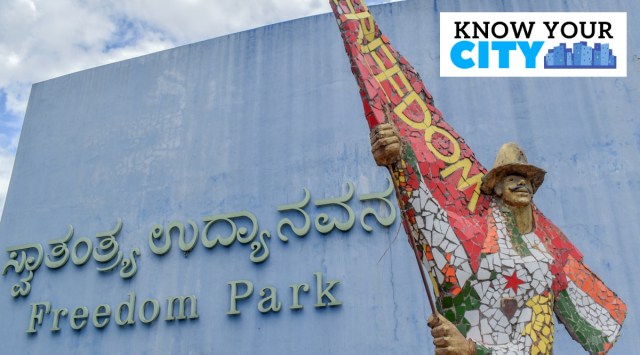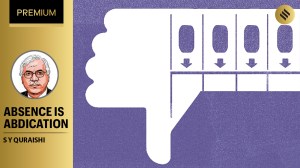Know your city: Freedom Park, a Bengaluru landmark and its link to India’s freedom struggle
From a jail where India’s freedom fighters were imprisoned to a protest site, Freedom Park has transformed over the years
 This famous city landmark in Gandhi Nagar once served as a prison. (Express photo by Jithendra M)
This famous city landmark in Gandhi Nagar once served as a prison. (Express photo by Jithendra M)Written by Ashiqa Jose M
If you thought that Freedom Park in Bengaluru was just a place where protests and exhibitions were held, think again. This famous city landmark in Gandhi Nagar once served as a prison, thus forging a link with India’s struggle for independence, and has great historical and cultural significance even today.
The park was inaugurated on February 28, 2009, by senior BJP leader L K Advani. “The spot was redesigned some time ago by Mathew and Ghosh Architects and converted into Freedom Park, where it was opened up as a gathering space for interactions. Now, it has turned into a famous site for protests, but various exhibitions and meetings are also held here. So it is quite a vibrant space right now,” says Yashaswini Sharma, a historian and an architect.
Currently maintained by Bruhat Bengaluru Mahanagara Palike (BBMP), 16 acres of the old prison area were converted into a recreational area that was opened to the public, while 5 acres were allotted for democratic protests and rallies. “Initially, these protests were held in Lalbagh, Cubbon Park, and some other places, but they used to obstruct traffic. So, they decided to allot some wider space here specifically for protests, while the other portion was retained since they did not want to lose the heritage aspect of the central jail,” says Suresh Moona, a well-known Bengaluru-based historian.
 The park was inaugurated on February 28, 2009, by senior BJP leader L K Advani. (Express photo by Jithendra M)
The park was inaugurated on February 28, 2009, by senior BJP leader L K Advani. (Express photo by Jithendra M)
Located on Sheshadri Road, the Freedom Park in Bangalore was home to the old Bengaluru Central Jail built by the British in 1867. Built on 21 acres of land, it was constructed to house the increasing number of freedom fighters during the freedom struggle. In 1942, during the Quit India Movement, several Congress Working Committee members, including former Karnataka chief minister K Hanumanthayya, former home minister M V Rama Rao, and leaders like H V Dasappa, P Subramanya and H Siddaiah, were jailed in this building. The jail also chambered the first gallows of the state. “The most important were the gallows, which were retained with a little modification. These were the gallows where the freedom fighters, mainly from Mysuru, walked to Bengaluru and were hanged, at the rate of two per day,” said Moona. The last hanging was in 1968; since then, hangings have been carried out at Hindalga Central Jail in Belagavi district.
Besides being a symbol of colonial rule, the jail also housed prisoners during the Emergency in 1975, where political leaders like the late Atal Bihari Vajpayee, Ramakrishna Hegde, and Advani were arrested and jailed here. In 2000, when the number of prisoners outnumbered its capacity, the prison was relocated to Parappana Agrahara.
 Besides being a symbol of colonial rule, the jail also housed prisoners during the Emergency in 1975. (Express photo by Jitendra M)
Besides being a symbol of colonial rule, the jail also housed prisoners during the Emergency in 1975. (Express photo by Jitendra M)
Despite its value, the government had initially planned to demolish the old structure. However, due to pressure from heritage activists, it was decided that it would be converted into a memorial where the gallows still stand. Therefore, in November 2008, the BBMP renamed this structure as Freedom Park.
Although the spot has undergone a makeover, several buildings from the past, such as the watchtower, barracks, and the entrance block, still remain intact. “The design of the prison complex was based on British philosopher Jeremy Bentham’s theory of a centralized penitentiary around a ‘panoptical’ or all-seeing tower. The built structure was placed around a central watch tower which allowed the jailors to keep a watch over the prisoners. The building displays features of colonial architectural style like arched openings, entablature, colonnaded balcony, and pitched roof, besides quoins at wall corners. And some of the buildings that existed at the central jail have been redesigned so that people can see how it functioned when it was a jail,” said Sharma.
 Built on 21 acres of land, it was constructed to house the increasing number of freedom fighters during the freedom struggle. (Express photo by Jithendra M)
Built on 21 acres of land, it was constructed to house the increasing number of freedom fighters during the freedom struggle. (Express photo by Jithendra M)
The barracks and the office of the chief warden are some of the aspects that have been retained, immortalising the historical value of the place. “Many heritage aspects have been retained, like the two big walls, the tower, and even the cells in their original form are there. Of course, several things have gone, but they have retained most of it. Even the cells for criminals are still there, which are very small with iron gates. So you can imagine the person living there for months and years, and their condition,” said Moona.
Though many components of the cultural landmark have been kept intact, the high walls have been painted to integrate the newer changes. Apart from the 300-seater amphitheatre, the new additions are a smaller theatre and a book museum with a cafe.
While a walk along the barracks is recommended, the park itself is a sight to behold.












